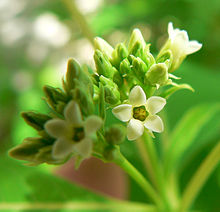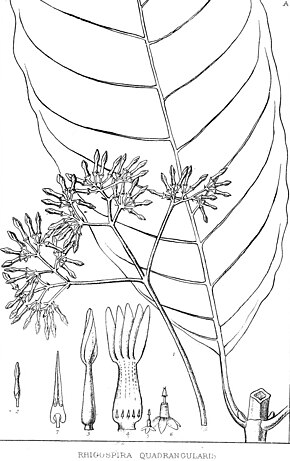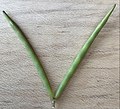Apocynaceae
| Apocynaceae | |
|---|---|

| |
| Apocynum cannabinum | |
| Scientific classification | |
| Kingdom: | Plantae |
| Clade: | Tracheophytes |
| Clade: | Angiosperms |
| Clade: | Eudicots |
| Clade: | Asterids |
| Order: | Gentianales |
| Family: | Apocynaceae Juss. |
| Type genus | |
| Apocynum | |
| Synonyms | |
Apocynaceae (/əˌpɑːsəˈneɪsiˌaɪ, -siːˌiː/, from Apocynum, Greek for "dog-away") is a family of flowering plants that includes trees, shrubs, herbs, stem succulents, and vines, commonly known as the dogbane family,[1] because some taxa were used as dog poison.[when?][2] Members of the family are native to the European, Asian, African, Australian, and American tropics or subtropics, with some temperate members.[1] The former family Asclepiadaceae (now known as Asclepiadoideae) is considered a subfamily of Apocynaceae and contains 348 genera. A list of Apocynaceae genera may be found here.
Many species are tall trees found in
Description

Growth pattern
The dogbane/milkweed
Leaves and stems
There is no stipule (a small leaf-like structure at the base of the leaf stem), or stipules are small and sometimes finger-like.[3]
Inflorescence and fruit

The fruit is a drupe, a berry, a capsule, or a (frequently paired) follicle.[1] The seeds are often winged or have appendages of long silky hairs.[9]
Taxonomy
As of 2012, the family was described as comprising some 5,100 species, in five subfamilies:[10]
- Apocynoideae Burnett, 1835
- Asclepiadaceae)
- Periplocoideae Endl., 1838
- Rauvolfioideae Kostel., 1834
- Secamonoideae Endl., 1838
The former family Asclepiadaceae is included in Apocynaceae according to the
376 genera are currently accepted.[13]
Distribution and habitat
Species in this family are distributed mainly in tropical regions:
- In the .
- In northern Australia: small evergreen trees such as Alstonia, Alyxia, Cerbera, and Ochrosia
- In deciduous forests of Africa, India, and
- In tropical America, India, Myanmar, and Malaya: evergreen trees and shrubs, such as Rauvolfia, Tabernaemontana, and Acokanthera.
- In Central America: Plumeria, or the frangipani, with its waxy white or pink flowers and a sweet scent.
- In South America, Africa, and Madagascar: many lianas, such as Landolphia
- In the Mediterranean region: Nerium oleander), and Apple of Sodom (Calotropis procera), with other (Calotropis) species extending into South Asia.
- The only genera found in temperate Europe away from the Mediterranean are Vinca (Rauvolfioideae) and Vincetoxicum (Asclepiadoideae). Also Asclepias syriaca is an invasive weed (e. g., in many areas of Ukraine).
- In North America: Apocynum, dogbane or Indian hemp, including Apocynum cannabinum, a traditional source of fiber. Also the bluestars, Amsonia, herbaceous perennials of upright habit, grown as ornamental plants for their attractive flowers.
- In continental southern Africa (Angola, Botswana, Eswatini, Mozambique, South Africa, and Zimbabwe) and Madagascar, except for the humid evergreen forest of the eastern side of Madagascar, and never above 2,000 m (6,600 ft) for the entire island: Pachypodium and Fockea.
Ecology
Several genera are preferred larval host plants for the Queen Butterfly (Danaus gilippus).[14]
Toxicity
Many species of plants from the family Apocynaceae have some toxicity, with some being extremely poisonous if parts are ingested, or if they are not handled properly. Genera containing cardiac glycosides—Cerbera, Nerium, Asclepias, Cascabela, Strophanthus,[6] Acokanthera,[15] Apocynum,[16] Thevetia,[17] etc.—have therapeutic ranges, but are often associated with accidental poisonings, in many cases lethal (see below). Alkaloid-producing species like Rauvolfia serpentina, Catharanthus roseus, and Tabernanthe iboga are likewise the source of compounds with therapeutic ranges, but which have significant associated toxicities if not taken in appropriate doses and in controlled fashion. (See below)
Uses
Several members of the family Apocynaceae have had economic uses in the past. Several are sources of important
Many genera are grown as ornamental plants, including Amsonia (bluestar),[27] Nerium (oleander),[28] Vinca (periwinkle),[29] Carissa (Natal plum),[30] Allamanda (golden trumpet),[31] Plumeria (frangipani),[32] Thevetia,[33] Mandevilla (Savannah flower),[34] and Adenium (desert-rose).[35]
In addition, the genera
There are limited dietary uses of plants from this family. The flower of
Finally, ethnopharmacologic and ethnotoxicologic uses are also known. The roots of
Many species are ornamental in gardens or as houseplants.
Gallery
Flowers
-
Alyxia oliviformis
-
Aspidosperma quebracho-blanco illustration in Köhler's Medizinal-Pflanzen
-
Cascabela thevetia (syn. Thevetia peruviana)
-
Nerium oleander
-
Pachypodium lamerei growth habit
-
Tabernanthe iboga in flower and fruit
-
Wrightia tinctoria single flower
Fruits
-
Adenium obesum dehiscence of single fruit.
-
Alyxia oliviformis
-
Amsonia tabernaemontana containerised specimen in fruit
-
Amsonia tabernaemontana single paired follicle detached from plant (paler, unsunned side)
-
Asclepias syriaca dehiscent follicles (before unfurling of pappi)
-
Asclepias curassavica dehiscent follicles shedding seeds with unfurled pappi
-
Cascabela thevetia (syn.Thevetia peruviana)
-
Cascabela thevetia (syn.Thevetia peruviana): dissection of toxic fruits.
-
Nerium oleander(dehiscence)
-
Saba senegalensis unripe fruit
-
Saba senegalensis: dissection of ripe, edible fruit
-
Strophanthus speciosus (dehiscence)
-
Tabernaemontana catharinensis (dehiscence)
-
Trachelospermum jasminoides (dehiscence)
-
Trachelospermum jasminoides: individual seeds, showing pappus
-
Vinca major (seeds)
-
Vinca minor: botanical plate showing paired fruits (no. 5)
Pachycaul species
-
Adenium obesum growth habit of wild specimens, Tanzania
-
Adenium obesum close-up of colossal specimen, Ghana
-
Adenium obesum trunk of extreme pachycaul specimen, Socotra
-
Pachypodium lamerei wild specimen of maximum height (approx 6 m (20 ft)) attained by species
-
Pachypodium lamerei in flower
-
Pachypodium lamerei mature, multi-trunked specimen cultivated in glasshouse
References
- ^ S2CID 31739212.
- ^ ISBN 9780123743800.
- ^ a b c Apocynaceae, Thomas Rosatti, Jepson Herbarium
- ^ "Apocynaceae usually have copious latex and the leaves are often opposite and with colleters...", retrieved 3/10/18 from ANGIOSPERM PHYLOGENY WEBSITE, version 13 http://www.mobot.org/MOBOT/Research/APweb/
- ^ Miers, J. (1878). On the Apocynaceae of South America, with some preliminary remarks on the whole family. p. 269.
- ^ a b c "PlantNET - FloraOnline: Apocynaceae". plantnet.rbgsyd.nsw.gov.au. Retrieved 2020-05-29.
- ^ a b "Stevens, P. F. (2001 onwards). Angiosperm Phylogeny Website. Version 14, July 2017 [and more or less continuously updated since]". Angiosperm Phylogeny Website. Retrieved 2020-05-30.
- ISBN 9781605353890.
- ^ "Apocynaceae Juss. | Plants of the World Online | Kew Science". Plants of the World Online. Retrieved 2020-05-29.
- ^ Nazia Nazar, David J. Goyder, James J. Clarkson, Tariq Mahmood and Mark W. Chase, 2013, "The taxonomy and systematics of Apocynaceae: Where we stand in 2012," Bot. J. Linn. Soc., 171(3, March), pp. 482–490, see [1], accessed 22 June 2015.
- hdl:10654/18083.
- .
- ^ Apocynaceae Juss. Plants of the World Online. Retrieved 24 July 2023.
- ^ Klots, Alexander B. (1951). A Field Guide to the Butterflies of North America, East of the Great Plains. Cambridge, Massachusetts: The Riverside Press. pp. 77–79.
- S2CID 208362795– via HeinOnline.
- S2CID 12653850.
- PMID 22196940.
- ^ "reserpine". drugcentral.org. Retrieved 2020-05-31.
- ISBN 9788184488418. Retrieved 2020-06-01.)
{{cite book}}: CS1 maint: multiple names: authors list (link - ISBN 9780123743800.
- ^ PMID 25642835.
- PMID 27734823.)
{{cite journal}}: CS1 maint: multiple names: authors list (link - S2CID 52277862.
- ^ ISBN 0-306-45465-3.
- S2CID 28177495.
- S2CID 37709142.
- ^ "StackPath: Growing Amsonia". www.gardeningknowhow.com. 22 June 2013. Retrieved 2020-06-01.
- ^ "Oleander". Better Homes & Gardens. Retrieved 2020-06-01.
- ^ "Annual Vinca". Better Homes & Gardens. Retrieved 2020-06-01.
- ^ "Carissa macrocarpa - Useful Tropical Plants". tropical.theferns.info. Retrieved 2020-06-01.
- ^ Agriculture and Fisheries (2015-10-30). "Yellow allamanda". www.business.qld.gov.au. Retrieved 2020-06-01.
- ^ "PLUMERIA RUBRA: AN OLD ORNAMENTAL, A NEW CROP". www.actahort.org. Retrieved 2020-06-01.
- ^ "Factsheet - Thevetia peruviana (Yellow Oleander)". keys.lucidcentral.org. Retrieved 2020-06-01.
- ^ "Propagating Mandevilla: Using Mandevilla Cuttings Or Seeds To Propagate Mandevilla Vine". 14 September 2010.
- ^ Archived at Ghostarchive and the Wayback Machine: Desert Rose Plant: How to Grow Desert Rose and Adeniums, retrieved 2020-06-01
- ^ Western Australian Herbarium. "FloraBase—the Western Australian Flora:Apocynaceae". florabase.dpaw.wa.gov.au. Biodiversity and Conservation Science. Retrieved 2020-05-29.
- ^ "Loroco: flower buds used as an herb". CooksInfo. Retrieved 2020-05-31.
- ^ "Floridata: Carissa macrocarpa (Natal plum)". floridata.com. Retrieved 2020-05-31.
- ^ Coville, F. V. (1897). "Notes On The Plants Used By The Klamath Indians Of Oregon" (PDF). Contributions from the U.S. National Herbarium. VII (3): 295–408–108 (p. 379). Archived from the original (PDF) on 2016-03-04. Retrieved 2020-05-29.
- ^ "Saba comorensis in Agroforestree Database" (PDF). Retrieved 30 July 2012.
- ^ "Pachypodium | PlantZAfrica". pza.sanbi.org. Retrieved 2020-05-31.
External links
- Apocynaceae in BoDD – Botanical Dermatology Database
 Media related to Apocynaceae at Wikimedia Commons
Media related to Apocynaceae at Wikimedia Commons Data related to Apocynaceae at Wikispecies
Data related to Apocynaceae at Wikispecies
Further reading
- A review on antimicrobial botanicals, phytochemicals and natural resistance modifying agents from Apocynaceae family: Possible therapeutic approaches against multidrug resistance in pathogenic microorganisms.




















































































